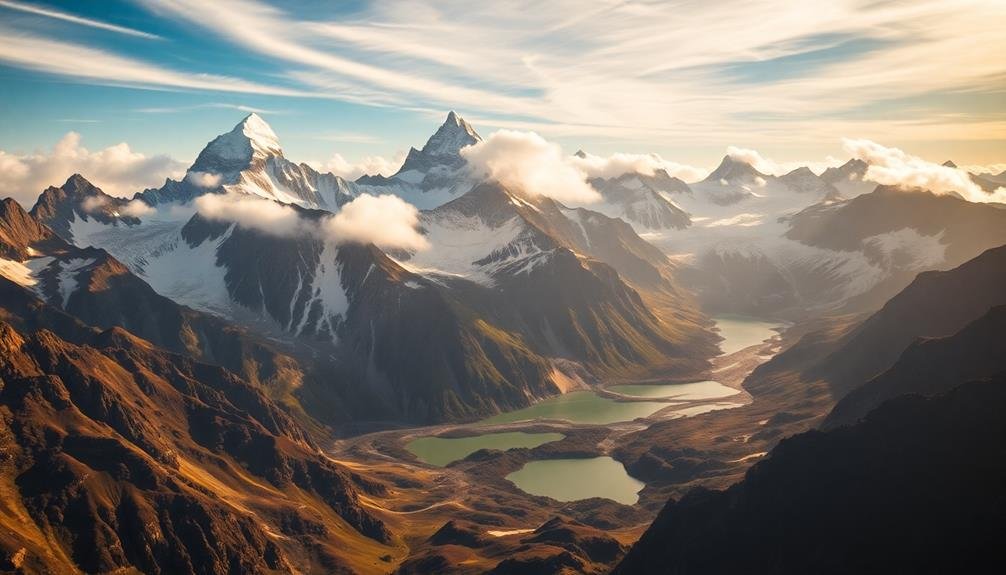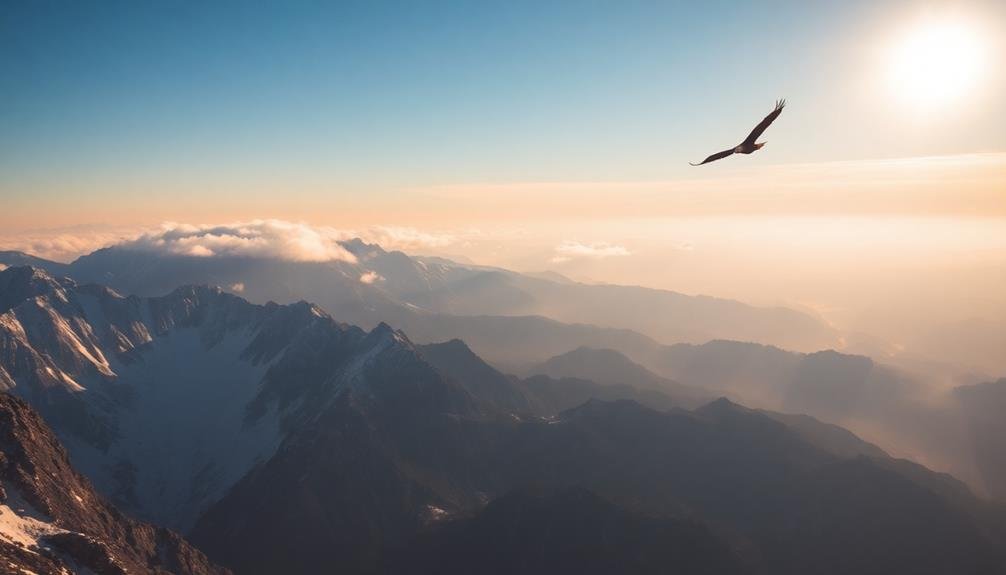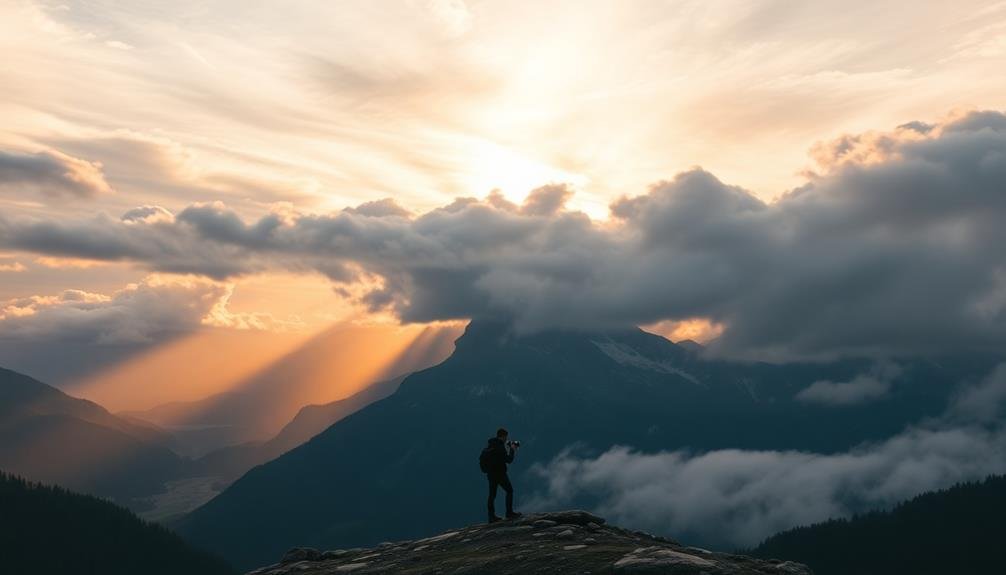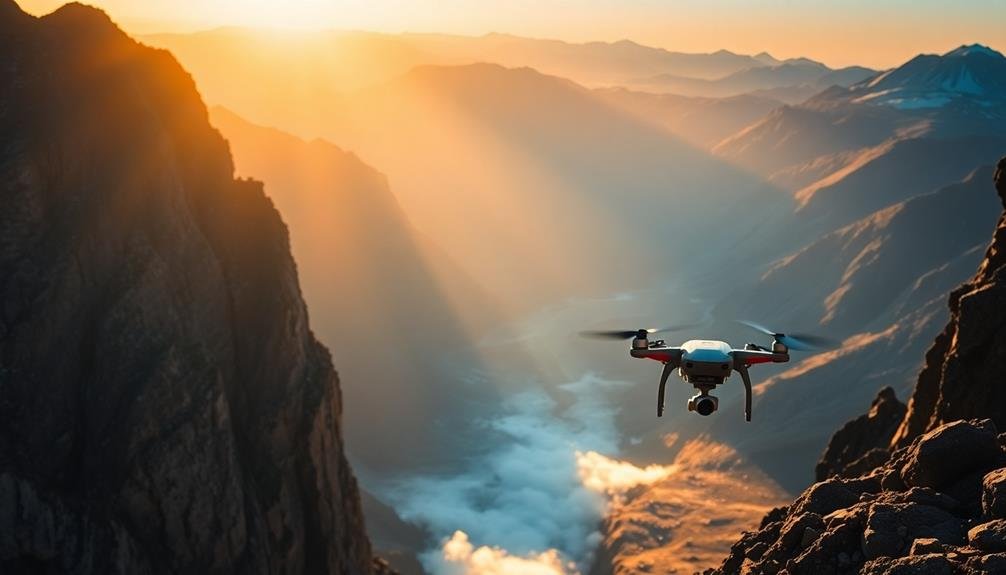For breathtaking mountain vistas, you'll want to explore iconic ranges like the Himalayas, Alps, Rocky Mountains, Andes, and New Zealand's Southern Alps. These locations offer diverse landscapes, from snow-capped peaks to turquoise lakes and dramatic glaciers. To capture stunning shots, consider using drones or small planes for aerial perspectives. Focus on golden hour lighting, interesting formations, and unique textures. Don't forget to adapt your approach for each season, as spring wildflowers, autumn foliage, and winter snow create distinct atmospheres. By mastering weather prediction and understanding altitude-specific patterns, you'll be well-equipped to seize those perfect, awe-inspiring moments.
Majestic Peaks From Above

Five breathtaking mountain ranges offer unparalleled aerial photography opportunities.
The Himalayas, with Mount Everest as their crown jewel, provide a stunning canvas of snow-capped peaks and treacherous ridges. You'll capture the world's highest mountains in all their glory, including K2 and Kangchenjunga.
The Alps present a different spectacle, with their jagged peaks interspersed with lush valleys and pristine lakes. The Matterhorn and Mont Blanc stand out as iconic subjects for your lens.
In North America, the Rocky Mountains stretch across vast wilderness, offering diverse landscapes from Colorado's colorful ranges to the Canadian Rockies' turquoise lakes.
The Andes, running along South America's western coast, showcase a variety of terrains. You'll photograph everything from the snow-capped peaks of Aconcagua to the otherworldly salt flats of Bolivia.
Finally, New Zealand's Southern Alps provide a unique blend of glaciers, fjords, and rugged peaks. Here, you'll capture the dramatic contrasts between Mount Cook's icy summit and the surrounding verdant landscapes.
Each range offers distinct photographic challenges and rewards, ensuring your aerial portfolio will be as diverse as it's breathtaking.
Capturing Alpine Lakes and Glaciers

Alpine lakes and glaciers offer some of the most mesmerizing subjects for aerial photography. As you soar above these pristine landscapes, you'll encounter a world of vibrant colors, intricate patterns, and breathtaking contrasts. To capture these natural wonders effectively, consider using a drone or chartering a small plane for the best vantage points.
When photographing alpine lakes, focus on their crystal-clear waters reflecting the surrounding mountains. Look for unique shapes and sizes, as well as any interesting features like islands or sandbars.
For glaciers, pay attention to the intricate crevasses, seracs, and ice formations that create stunning textures and patterns.
To make the most of your alpine lake and glacier photography, keep these tips in mind:
- Use polarizing filters to reduce glare and enhance water clarity
- Experiment with different altitudes to capture varying perspectives
- Shoot during golden hour for warm, dramatic lighting
- Include scale references like boats or hikers to emphasize the landscape's grandeur
Remember to respect local regulations and wildlife when photographing these delicate ecosystems.
With careful planning and execution, you'll create stunning images that showcase the raw beauty of alpine lakes and glaciers from above.
Soaring Over Mountain Ridges

As you venture into aerial photography of mountain ridges, you'll discover a world of dramatic landscapes and awe-inspiring vistas. The key to capturing stunning ridge shots is timing and perspective. Aim for early morning or late afternoon when the sun casts long shadows, accentuating the rugged terrain.
Choose your vantage point carefully. Helicopters offer versatility, allowing you to hover and adjust your position. Alternatively, small planes can cover more ground, ideal for expansive ridge systems. Drones provide a cost-effective option but have limited range and altitude capabilities.
When composing your shots, look for interesting formations like jagged peaks, knife-edge ridges, or serpentine paths. Use leading lines to guide the viewer's eye across the frame. Include elements like snow-capped summits or alpine meadows for contrast and scale.
Consider your camera settings carefully. A fast shutter speed is vital to combat vibrations and maintain sharpness. Opt for a wider aperture to guarantee your entire scene is in focus.
Don't forget to bracket your exposures, as high-altitude light can be tricky to meter accurately.
Sunrise and Sunset Drone Flights

While mountain ridges offer breathtaking aerial views, capturing the golden hours from above adds a new dimension to sky-high photography. Drone flights during sunrise and sunset provide unique opportunities to capture the landscape bathed in warm, ethereal light. You'll need to plan carefully, considering local regulations and weather conditions.
To make the most of your sunrise and sunset drone flights:
- Scout locations in advance, identifying potential hazards and ideal takeoff spots.
- Arrive early to set up your equipment and allow time for any last-minute adjustments.
- Use filters to balance exposure and enhance colors, especially when shooting directly into the sun.
- Experiment with different altitudes and angles to capture the changing light and shadows.
Remember to keep your drone within sight and respect wildlife and other photographers.
The soft, warm light during these golden hours can transform ordinary landscapes into extraordinary scenes. You'll capture long shadows stretching across valleys, sunbeams piercing through clouds, and mountain peaks glowing with alpenglow.
With practice, you'll master the art of timing your shots to capture the perfect moment when the sun kisses the horizon, creating unforgettable images that showcase the beauty of our world from above.
Seasonal Changes in Mountain Landscapes

You'll witness nature's grand spectacle as mountain landscapes transform throughout the year.
In spring, melting snow reveals new growth and awakening wildlife, while autumn paints the slopes with a vibrant palette of reds, oranges, and golds.
Winter brings a magical transformation, blanketing the peaks and valleys in pristine snow, creating a photographer's paradise of stark contrasts and ethereal scenes.
Spring Thaw Awakens Nature
With the arrival of spring, mountain landscapes transform into a photographer's paradise. As winter's icy grip loosens, you'll witness nature's rebirth unfold before your lens. The spring thaw brings a surge of life and color to previously dormant slopes, creating enchanting scenes for your camera.
You'll want to capture the following spring phenomena in your mountain photography:
- Rushing waterfalls and streams, swollen with melting snow
- Vibrant wildflowers carpeting alpine meadows
- New growth on trees, with bright green leaves unfurling
- Wildlife emerging from hibernation, including bears and marmots
Position yourself to capture the interplay of light and shadow as the sun climbs higher in the sky. Early mornings offer the best chance to photograph mist rising from valleys and lakes, creating ethereal scenes.
Don't forget to include contrasting elements in your compositions, such as lingering snow patches against fresh grass. As you explore, be mindful of fragile ecosystems and stick to designated trails.
Spring weather can be unpredictable, so pack appropriate gear and clothing. With patience and a keen eye, you'll capture stunning images that showcase the mountain's springtime revival.
Autumn's Vibrant Color Palette
Autumn's arrival transforms mountain landscapes into a photographer's dream. As temperatures drop, deciduous trees paint the slopes in a breathtaking array of reds, oranges, and golds. This seasonal spectacle offers endless opportunities for capturing stunning images.
To make the most of autumn's vibrant palette, you'll want to time your visit carefully. Peak foliage typically occurs in late September to mid-October, depending on the mountain range and elevation. Research your chosen location to pinpoint the ideal timeframe.
Early morning and late afternoon provide the best lighting conditions for autumn photography. The golden hour casts a warm glow on the colorful leaves, enhancing their natural beauty. Look for compositions that contrast the vibrant foliage against evergreen trees, rocky outcrops, or mountain streams.
Don't limit yourself to wide landscape shots. Zoom in on individual leaves, capture the interplay of light and shadow on tree trunks, or frame a distant peak through a foreground of colorful branches.
Remember to include some blue sky in your shots to balance the warm tones of the foliage.
Winter's Snowy Wonderland Transformation
As autumn's fiery display fades, winter blankets mountain landscapes in a pristine white wonderland. You'll witness a stunning transformation as snow-capped peaks pierce through clouds, creating a serene and otherworldly atmosphere.
This seasonal shift offers photographers unique opportunities to capture breathtaking scenes that showcase nature's raw beauty.
To fully appreciate winter's snowy transformation, keep an eye out for these enchanting elements:
- Frosted trees: Evergreens and bare deciduous trees alike become adorned with intricate ice crystals, creating a magical forest scene.
- Frozen waterfalls: Cascading water turns to ice, forming spectacular sculptures that glisten in the sunlight.
- Snow-covered valleys: Rolling hills and deep valleys become smooth, undulating expanses of white, perfect for capturing minimalist compositions.
- Alpine wildlife: Animals like mountain goats, bighorn sheep, and ptarmigans stand out against the snowy backdrop, offering unique wildlife photography opportunities.
As you frame your shots, pay attention to the interplay of light and shadow on the snow-covered terrain. The low winter sun can create dramatic contrasts, long shadows, and golden hour effects that last longer than in other seasons, giving you ample time to perfect your compositions.
Navigating Weather for Perfect Shots

You'll need to master the art of predicting clear sky conditions to capture stunning sky-high shots.
It's essential to understand altitude-specific weather patterns, as conditions can change rapidly at higher elevations.
Don't forget to take into account seasonal lighting variations, which can dramatically affect the mood and quality of your mountain photography.
Predicting Clear Sky Conditions
For breathtaking sky-high photography, clear conditions are essential. You'll need to predict when the skies will be at their clearest to capture those perfect shots. Start by checking local weather forecasts and satellite imagery to gauge cloud cover and atmospheric conditions.
Pay attention to high-pressure systems, which often bring clear skies and stable weather.
Consider using specialized apps and websites designed for photographers and astronomers. These tools can provide detailed predictions for visibility, cloud cover, and even the likelihood of dramatic sunrises or sunsets.
Don't forget to factor in seasonal variations and local climate patterns that might affect sky clarity.
To increase your chances of finding clear skies, keep these tips in mind:
- Plan your shoots during the driest seasons in your area
- Look for locations with higher elevations, which often have clearer air
- Check for air quality reports to avoid days with high pollution or haze
- Monitor wind patterns, as strong winds can quickly change sky conditions
Altitude-Specific Weather Patterns
Understanding altitude-specific weather patterns is essential when you're aiming for perfect sky-high shots. As you climb higher, you'll encounter distinct weather phenomena that can greatly impact your photography.
At lower elevations, you might experience fog or mist in the early morning, which can create ethereal landscapes. Mid-altitude areas often see rapidly changing conditions, with clouds forming and dissipating quickly.
Above the tree line, you'll face more extreme weather. Wind speeds typically increase with altitude, so be prepared for gusts that can affect your camera's stability. Temperature drops about 3.5°F for every 1,000 feet of elevation gain, so dress in layers.
At higher altitudes, you're more likely to encounter lenticular clouds, which can add unique elements to your compositions.
Be aware of orographic lift, where air is forced upwards by mountain slopes, often creating clouds on the windward side. This effect can lead to unexpected precipitation or dramatic cloud formations.
Always check local weather forecasts specifically for your target elevation, as conditions can vary considerably from the base to the summit. By understanding these altitude-specific patterns, you'll be better equipped to capture stunning sky-high photographs.
Seasonal Lighting Considerations
Seasonal lighting shifts dramatically impact sky-high photography, adding another layer of complexity to weather considerations. You'll need to adjust your approach based on the time of year to capture stunning mountain vistas.
In winter, the sun sits lower on the horizon, creating longer shadows and softer light. Summer brings higher sun angles, harsher contrasts, and extended golden hours.
To make the most of seasonal lighting, consider these factors:
- Sun position: Track the sun's path across the sky during different seasons to plan your shots.
- Golden hour duration: Longer in summer, shorter in winter, affecting your shooting window.
- Shadow play: Winter's low sun casts longer shadows, creating dramatic landscapes.
- Color temperature: Seasonal variations in atmospheric conditions influence the light's warmth or coolness.
You'll want to research sunrise and sunset times for your chosen location and season. Plan your ascent or descent accordingly, allowing ample time to set up your equipment.
Don't forget to account for rapidly changing weather conditions at high altitudes, which can quickly alter lighting scenarios. By understanding and adapting to seasonal lighting patterns, you'll capture breathtaking mountain photographs year-round.
Drone Safety in High Altitudes

Maneuvering the skies with a drone at high altitudes requires extra caution and preparation. You'll need to take into account the thinner air, which affects your drone's performance and battery life.
At higher elevations, your drone's propellers generate less lift, making it work harder to stay airborne. This increased strain can dramatically reduce flight time and control responsiveness.
Before launching, check local regulations and obtain necessary permits for flying in mountainous areas. Many national parks and protected zones have strict drone policies.
Always maintain visual line of sight with your drone, which can be challenging in rugged terrain. Be aware of sudden weather changes common at high altitudes, including strong winds and unexpected cloud cover.
Monitor your drone's battery levels closely, as they drain faster in colder temperatures typical of high altitudes. Plan shorter flights and bring extra batteries.
Use your drone's return-to-home function conservatively, as it may struggle to climb back to you in thin air.
Frequently Asked Questions
What Camera Equipment Is Essential for Mountain Photography?
You'll need a sturdy tripod, wide-angle lens, and weather-sealed camera for mountain photography. Don't forget filters, a remote shutter release, and extra batteries. A lightweight backpack to carry your gear is also essential.
How Can I Protect My Gear From Extreme Mountain Conditions?
You'll need to shield your gear from harsh mountain conditions. Use weatherproof cases, silica gel packets, and lens filters. Keep batteries warm, clean equipment regularly, and avoid rapid temperature changes. Don't forget insurance for added peace of mind.
Are Permits Required for Drone Photography in Mountain Areas?
You'll often need permits for drone photography in mountain areas. Check local regulations before flying. Many national parks and protected areas restrict or ban drones. Always research specific rules for your chosen location to avoid fines or legal issues.
What Post-Processing Techniques Enhance Mountain Landscape Photos?
You'll enhance your mountain landscape photos by adjusting contrast, boosting saturation, and sharpening details. Don't forget to experiment with HDR techniques, graduated filters, and selective color adjustments. Fine-tune your white balance for accurate sky hues.
How Do I Find Lesser-Known Mountain Photography Locations?
To find hidden mountain photo spots, you'll want to research local hiking forums, talk to park rangers, explore satellite imagery, and venture off popular trails. Don't forget to check social media for lesser-known locations tagged by other photographers.
In Summary
You've now got the tools to capture breathtaking mountain vistas from above. Remember, patience and preparation are key. Always prioritize safety, respect local regulations, and be mindful of wildlife. As you soar over majestic peaks, alpine lakes, and rugged ridges, you'll discover new perspectives that ground-based photography can't match. Whether it's a sunrise flight or a seasonal landscape, you're ready to create stunning aerial images that'll leave viewers in awe.

As educators and advocates for responsible drone use, we’re committed to sharing our knowledge and expertise with aspiring aerial photographers.




Leave a Reply